Influence of osteopathic cervical manipulation on blood flow velocity of the cerebral circulation in chronic neck pain: analysis of three groups
Influência da manipulação osteopática cervical na velocidade de fluxo sanguíneo da circulação cerebral em indivíduos com cervicalgia crônica: análise de três grupos
Rafael Stelle; Bianca Simone Zeigelboim; Marcos Christiano Lange; Jair Mendes Marques; François Ricard; Cleofás Rodríguez Blanco
Abstract
Keywords
Resumo
Palavras-chave
References
Bevilagua-Grossi D, Pegoretti KS, Gonçalves MS, Speciali JG, Bordini CA, Bigal ME. Cervical mobility in women with migraine. Headache. 2009;49(5):726-31.
Rueda VG, Celis CL, López Meb, Uribarren AC, Tomás SC, García CH. Effectiveness of a specific manual approach to the suboccipital region in patients with chronic mechanical neck pain and rotation deficit in the upper cervical spine: study protocol for a randomized controlled trial. BMC Musculoskelet Disord. 2017;18:384.
Jørgensen MB, Skotte JH, Holtermann A, Sjøgaard G, Petersen NC, Søgaard K. Neck pain and postural balance among workers with high postural demands - a cross-sectional study. BMC Musculoskelet Disord. 2011;12:176.
Field S, Treleaven J, Jull G. Standing balance: a comparison between idiopathic and whiplash-induced neck pain. Man Ther. 2008;13(3):183-91.
Stelle R, Zeigelboim BS, Lange MC, Marques JM. Influence of osteopathic manipulation on blood flow velocity of the cerebral circulation in chronic mechanical neck pain. Rev Dor. 2014;15(4):281-6.
Stelle R, Zeigelboim BS, Lange MC, Marques JM. Influence of manipulation at range of rotation of the cervical spine in chronic mechanical neck pain. Rev Dor. 2013;14(4):284-9.
Bielinska M, Olszewski J. Results evaluation in cervical vertigo kinesitherapy--preliminary report. Otolaryngol Pol. 2009;63(7):24-7.
Treleaven J. Sensorimotor disturbances in neck disorders affecting postural stability, head and eye movement control - Part 2: case studies. Man Ther. 2008;13(3):266-75.
Treleaven J. Sensorimotor disturbances in neck disorders affecting postural stability, head and eye movement control. Man Ther. 2008;13(1):2-11.
Thomas LC, Rivett DA, Bolton PS. Pre-manipulative testing and the use of the velocimeter. Man Ther. 2008;13(1):29-36.
Silva AL, Marinho MR, Gouveia FM, Silva JG, Ferreira AS, Cal R. Benign paroxysmal positional vertigo: comparison of two recent international guidelines. Braz J Otorhinolaryngol. 2011;77(2):191-200.
Barbosa MF, Abdala N, Carrete Jr H, Nogueira RG, Nalli DR, Fonseca JR. [Reference values for measures of blood flow velocities and impedance indexes in healthy individuals through conventional transcranial Doppler]. Arq. Neuropsiquiatr.. 2006;64(3B):829-38.
Galindez-Ibarbengoetxea X, Setuain I, Ramírez-Velez R, Andersen LL, González-Izal M, Jauregi A. Short-term effects of manipulative treatment versus a therapeutic home exercise protocol for chronic cervical pain. A randomized clinical trial. J Back Musculoskelet Rehabil. 2018;31(1):133-45.
Cleland JA, Mintken PE, Carpenter K, Fritz JM, Glynn P, Whitman J. Examination of a clinical prediction rule to identify patients with neck pain likely to benefit from thoracic spine thrust manipulation and a general cervical range of motion exercise: multi-center randomized clinical trial. Phys Ther. 2010;90(9):1239-50.
Creighton D, Kondratek M, Krauss J, Huijbregts P, Qu H. Ultrasound analysis of the vertebral artery during non-thrust cervical translatoric spinal manipulation. J Man Manip Ther. 2011;19(2):84-90.
Pérez-Llanes R, Ríos-Díaz J, Martínez-Payá JJ, Del-Banõ-Aledo ME. Ultrasonography analysis of vertebral artery blood flow velocity changes on produced by the maximal cervical rotation. Fisioterapia. 2012;34(3):118-24.
Maduro-de-Camargo V, Alburquerque-Sendín F, Bérzin F, Cobos-Stefanelli V, Rodrigues-Pedroni C, Santos K. Immediate effects of the ashmore manipulation technique C5/C6, in muscle activity in patients with mechanical neck pain. Eur J Ost Clin Rel Res. 2012;7(1):2-9.
Orelli JG, Rebelatto JR. The effectiveness of manual therapy in individuals with headaches, with and without cervical degeneration: analysis of six cases. Rev Bras Fisioter. 2007;11(4):325-9.
Leon-Sanchez A, Cuetter A, Ferrer G. Cervical spine manipulation: an alternative medical procedure with potentially fatal complications. South Med J. 2007;100(2):201-3.
Mikkelsen R, Dalby RB, Hjort N, Simonsen CZ, Karabegovic S. Endovascular treatment of basilar artery thrombosis secondary to bilateral vertebral artery dissection with symptom onset following cervical spine manipulation therapy. Am J Case Rep. 2015;16:868-71.
Chung CL, Côte P, Stern P, L'Espérance G. The association between cervical spine manipulation and carotid artery dissection: a systematic review of the literature. J Manipulative Physiol Ther. 2015;38(9):672-6.
Herzog W, Leonard TR, Symons B, Tang C, Wuest S. Vertebral artery strains during high-speed, low amplitude cervical spinal manipulation. J Electromyogr Kinesiol. 2012;22(5):740-6.
Haneline M, Triano J. Cervical artery dissection. A comparison of highly dynamic mechanisms: manipulation versus motor vehicle collision. J Manipulative Physiol Ther. 2005;28(1):57-63.
Wynd S, Anderson T, Kawchuk G. Effect of cervical spine manipulation on a pre-existing vascular lesion within the canine vertebral artery. Cerebrovasc Dis. 2008;26(3):304-9.
Yazici B, Erdogmus B, Tugay A. Cerebral blood flow measurements of the extracranial carotid and vertebral arteries with Doppler ultrasonography in healthy adults. Diagn Interv Radiol. 2005;11(4):195-8.
Submitted date:
05/19/2017
Accepted date:
04/23/2018


